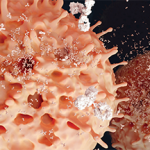Altered fatty acid metabolism may play a specific role in the early development RA prior to the clinical onset of synovitis.13,23 These factors will all need to be considered and studied in the context of RA prevention, although it may well be that given the potential general health benefits of many of these factors, they should be widely implemented in anyone, even those who are not at risk for RA.
Another important aspect of a preventive intervention for RA will be to determine how long the intervention needs to be applied to see benefit. For a drug, the field may hope that a short course may reset the immune system and impart lasting reduced risk. However, based on the preliminary findings from the PRAIRI study, in which disease was only delayed, as well as findings from an older study in ACPA-positive individuals in whom two doses of intramuscular corticosteroids did not halt progression to RA, it may be that drugs should be used long term to prevent clinically apparent RA.24
That approach may have challenges compared with short-term treatment in terms of adherence and potential for side effects, but it still may be beneficial for an individual if they never have a first flare of disease or other long-term adverse effects of clinically apparent RA. In addition, individuals who do not transition to clinically apparent arthritis may also be able to use a safer and potentially less expensive therapy compared with an individual who presents with more aggressive disease. For nonpharmacologic interventions, such as smoking cessation, improved lifestyle and weight loss, to have long-term benefit, these lifestyle interventions may need to be longstanding to have lasting benefit.
Motivating individuals to be assessed for their risk and to participate in preventive activities, such as medications or lifestyle changes, will be critical. This participation depends on a variety of factors, including awareness of RA as a disease and an individual’s real and perceived risk for RA, that may be influenced by predictive models and personal factors. Individual preferences for preventive treatments have been studied and found to be based on a combination of factors, including perceptions of risk and the safety and duration of an intervention.25-27
A recently completed trial randomly assigned 238 unaffected first-degree relatives to receive either an RA risk assessment, called PRE-RA, personalized to their lifestyle, RF/ACPA and genetic results, and demographic characteristics or standard information about RA without personalized results.26 At baseline, few relatives were able to identify known RA risk factors, such as smoking. However, knowledge of RA risk factors and motivation to change RA risk-related behaviors both improved during follow-up among relatives who received the personalized PRE-RA risk score compared with those who received the standard RA education. These results suggest that relatives are willing to be assessed for RA risk and that, after education, they are willing to improve their lifestyles once they understand the risk factors for RA.


